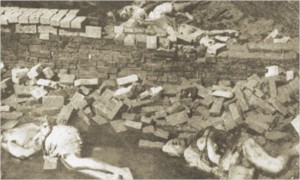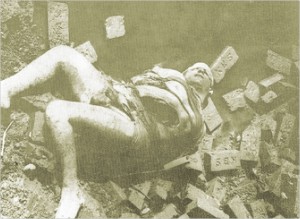Journey through Bangldesh
From Sylhet
31st August 1971:
A black day for Sylhets Iqbal Siddiquee
 Thirty-first August is a black day in the history of our liberation war. On this day, 35 years ago, the then Occupation Pak army shot 126 innocent villagers dead in a planned attempt and without any provocation at a remote village in the district of the then Sylhet (now Sunamganj). The local collaborators also attributed a great role in the cruel incident of cool blooded murders while as many as 150 shops in the adjacent rural bazar were also burnt to ashes. Thirty-first August is a black day in the history of our liberation war. On this day, 35 years ago, the then Occupation Pak army shot 126 innocent villagers dead in a planned attempt and without any provocation at a remote village in the district of the then Sylhet (now Sunamganj). The local collaborators also attributed a great role in the cruel incident of cool blooded murders while as many as 150 shops in the adjacent rural bazar were also burnt to ashes.
Still the villagers, as well as the people of greater Sylhet, remember the day with great sorrow and shock in a sense. However, it is considered a milestone in the history of liberation war of the region as well as of the country.
It was Tuesday. About 20 to 30 members of Pakistan Army on 8 to 9 boats came to the Srairamshi bazar of Jagannathpur thana at about 10 AM. They asked the villagers of Sriramshi and the adjacent ones to gather at the just attached Sriramshi High School building immediately for joining a discussion to form peace committee. Some of the local collaborators also made an announcement. They also said, the measure had been taken to avoid any untoward incident and for ensuring peace in the remote villages. Otherwise, there would be a mass killing, they warned. Accordingly, the villagers about 200 in number with a sincere belief, reached the school ground. A Rajaker leader from the nearby Hobibpur-Ahmed Ali Khan whispered an army man something, resulting in an action by some others with Sten gun and other weapons.
 As the villagers were waiting for the so-called meeting with great anxiety, the army men took some young students, teachers and others to a separate room in the school. Again they picked up groups of 15 to 16 people to separate groups kept along the narrow canal, that flows between the school and the small bazar. Also the army tied their hands,pulling them behind their back. Within a short time, the killers stood them up in a square and asked them to recite their Kalema. Things went wrong and before the innocent villagers could realize any thing, the Pak army opened brush fire on the Bangalees. As many as 126 innocent people were shot dead and they embraced martyrdom. The unknown village became a part of the great history of the nation's liberation war. As the villagers were waiting for the so-called meeting with great anxiety, the army men took some young students, teachers and others to a separate room in the school. Again they picked up groups of 15 to 16 people to separate groups kept along the narrow canal, that flows between the school and the small bazar. Also the army tied their hands,pulling them behind their back. Within a short time, the killers stood them up in a square and asked them to recite their Kalema. Things went wrong and before the innocent villagers could realize any thing, the Pak army opened brush fire on the Bangalees. As many as 126 innocent people were shot dead and they embraced martyrdom. The unknown village became a part of the great history of the nation's liberation war.
The water in the narrow canal became reddish with the blood of peace loving men, who were just cheated by the killers. The dead included, Post master, Tahsilder, UP Member, students, youth, traders and local elites. Then the army men poured kerosene oil in the shops in the market and set those on fire. There was no sound or any cry of protest.
Then the occupation army men went on rampage at the
village. Also they set some of the dwelling houses and shops at the bazaar ablaze. With the spread of the news of such a mass killing, the rest of the people also left their homesteads in the remote villages nearby.
 However, after 3 days, a handful of people from the nearby villages managed to reach the village and found some of the remains of the human bodies and buried those somehow. Meantime, dogs and foxes had done a lot on those bodies. However, after 3 days, a handful of people from the nearby villages managed to reach the village and found some of the remains of the human bodies and buried those somehow. Meantime, dogs and foxes had done a lot on those bodies.
Some of the dead were identified as Headmaster Saad Uddin, Tahshilder Ahea Chowdhury, Satya Narayan Chakravarty, Syed Ashraf Hossain, Shafiqur Rahman, Firoze Miah, Sunu Miah, Ala Miah, Nozir Miah, Abdul Mannan, Waris Miah, Manik Miah, Abdul Jalil, Dobir Miah, Morom Ullah, Montaj Ali, Sarwar Ullah, Rais Ullah, Abdul Majid, Abdul Latif Ekhlas Miah, Mokhtar Miah, Samir Ali, Abdul Hai, Shamsu Miah, Soab Ullah, Rufu Miah, Rusmot Ali, Asab Miah, Taiyab Ali, Roab Ali, Tofazzal Ali, Mosoddor Ali, Abdul Hannan, Abdul Barik member, Shudhangshu tailor, Syed Jahir Uddin, Post Master of Sriramshi post office.
Crippled Amjad Ali with bullet on his body still bears the black memory of that day. The other bullet wounds include Soil Uddin, Haji Alkas Miah, Zoahir Chowdhury, Amzad Ali, Topon Chakravarty, Sundar Ali,, Hushiar Ali, and Alkas Ali.
The incident got a wide coverage in the world media including the BBC also. Same way, the Pak army men enacted a similar incident at Raniganj bazar in Jagannathpur upazila on 8 September when 30 people were shot dead in a brush fire. Also they burnt out the Raniganj bazar soon after.
After the end of the liberation war, Commander in Chief of the war-Gen MAG Osmani and the then Agriculture minister Abdus Samad Azad visited the Sriramshi village to pay homage to the luminous sons. Azad was born at the same upazila. Also he was elected to the parliament from that constituency. Besides, there had been many commitments to take measures for remembering the martyrs. The remote village was once named Shahid Nagar, but it did not continue. Some of the important personalities told us about many other things that has happened there.
With the assistance from the Sunamganj district unit of Bangladesh Muktijodha Sangsad, a small plate inscribing the names of the great sons was constructed in 1980 at the premises of the school. Later, the locals gave up the hope of getting government assistance and locally managed things. They formed Sriramshi Shahid Smriti Sangsad in 1987 for commemorating the martyrs and their sacrifice. Since then, the Sangsad organizes annual events to remember those valiant sons of the soil. It also publishes annual magazines styled 'Chetona' as a yearly event.
Two small monuments have been constructed at the area. One was constructed 2 years ago at the very place where the killing took place. It is in the Biswanath Upazila. The earlier one was constructed at the school premises, which falls in the Jagonnathpur upazila.
Copyright
(R) thedailystar.net 2006 |
|
